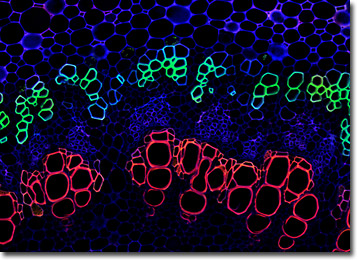 |
 |
 |
|
||||||||||||||||||||||||
 | ||||||||||||||||||||||||
 | ||||||||||||||||||||||||
 | ||||||||||||||||||||||||
Confocal Microscopy Image Gallery
Plant Tissue Autofluorescence Gallery
Rubber Tree Leaf
The vast majority of natural rubber utilized for commercial purposes is acquired from Hevea brasiliensis, commonly known as the rubber tree. The tree is indigenous only to tropical and some subtropical areas of South America, and natives in these regions had been obtaining and utilizing the milky white juice known as latex from them for many years before the arrival of the first European explorers.

These explorers brought samples of the unusual material back with them to Europe, where it was at first considered an oddity, but was then found to have a variety of practical applications. Early South Americans were able to produce waterproof bottles from latex, but the Europeans had little success with this practice initially. In 1770, however, a British chemist, Joseph Priestly, discovered that rubber was capable of erasing pencil markings, and later in the same century another British chemist, Charles Macintosh, began producing waterproof raincoats with the material, giving birth to the rubber industry, which has expanded steadily ever since.
In the 1870s, the first successful rubber tree plantations outside of South America were established after tens of thousands of Hevea brasiliensis seeds were smuggled out of Brazil. Today, most of the world’s natural rubber is harvested from trees grown in parts of Southeast Asia often collectively referred to as the rubber belt. The plantations in these areas are usually very large, and workers obtain the important material by regularly tapping the trees. The process of tapping, if carried out properly, does not adversely affect tree health.
Additional Confocal Images of Rubber Tree Leaf
Rubber Tree Leaf at High Magnification - The latex of the rubber tree flows through special ducts located outside of the cambium so that it can be accessed through relatively shallow incisions without harming the growing cells that generate the tree’s vascular system.
Contributing Authors
Nathan S. Claxton, Shannon H. Neaves, and Michael W. Davidson - National High Magnetic Field Laboratory, 1800 East Paul Dirac Dr., The Florida State University, Tallahassee, Florida, 32310.
